Catocala of Michigan
Catocala unijuga form agatha, Ogemaw County, Michigan,
July 4, 2012, courtesy of Cindy Mead.
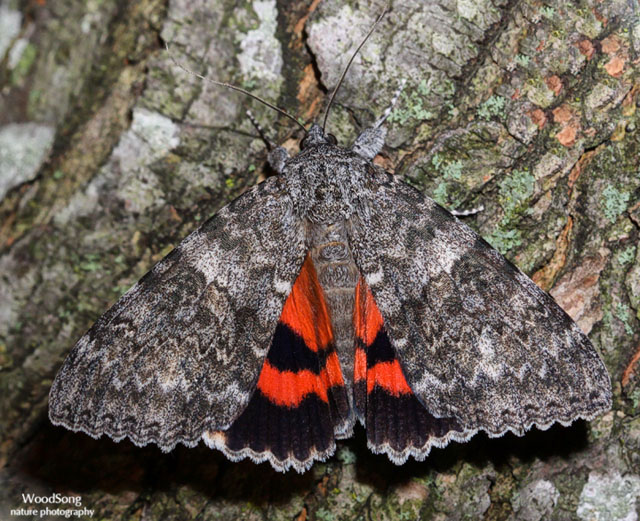
Catocala unijuga form agatha, Ogemaw County, Michigan,
July 4, 2012, courtesy of Cindy Mead.
Many thanks to Cindy Mead of Ogemaw County who has documented many species from Michigan and has shared images and data.
The University of Michigan Museum of Zoology (UMMZ) lists the following species: Catocala briseis, Catocala ilia, Catocala innubens, Catocala insolabilis, Catocala relicta, and Catocala unijuga.
Catocala amestris is on Michigan's Endangered Species list. Catocala robinsoni was reported in southeastern Michigan in late 1800's early 1900's. There have been no recent reports. It may be rare, endangered or even extinct in Michigan (Michigan Natural Features Inventory). Catocala dulciola, southwestern Michigan is considered extremely rare (MICHIGAN’S WILDLIFE ACTION PLAN SGCN STATUS & SPECIES-SPECIFIC ISSUES). Ilia, palaeogama, retecta, sordida and gracilis are specifically mentioned in 1968 Journal of Lepidopterist Society (1968 JLS) as occuring in Pinkney, Michigan. Apparently at least thirty Catocala species were encountered at MV lights near the University of Michigan.
Those species followed by OWO have been confirmed in Ontario, Wisconsin and Ohio. I feel they are almost assuredly in Michigan. Those species followed by OO have been confirmed in Ontario and Ohio. They have a good chance of being at least in eastern Michigan. Those species in Illinois (IL) and Wisconsin (W) have a good chance of being at least in southwestern Michigan. Those species from Wisconsin (W) and Ohio (Oh) have a chance of being in southern Michigan.
Remarkably, just after posting this list, Harry King, who has been collecting Catocala in Michigan along with Mo Nielsen for over fifty
years, sent me a copy of the Catocala section of Revised Checklist of the Moths of Michigan as published in the MES Newsletter Volume 50, Numbers 1 &
2, March 2005.
The list was compiled by Mo Nielsen. All those species followed by * are confirmed on Mo's list. I have added alabamae, badia, luciana, angusi and
ulalume, based on Mo's
publication. I retain whitneyi and abbreviatella from my original list. These two species, however, may be absent from Michigan or may be scarce and
limited to the extreme south and west as both are taken in Illinois and Wisconsin. I also retain maestosa, a rare species, which has been taken in
both Wisconsin and Ohio, so I suspect it may also be in extreme southern Michigan.
Harry has sent me much data and many excellent recto and verso images, all of which are being posted to the Harry King,
Michigan Catocala Collection.
Harry writes October 6, 2008, "You notice these specimens are all taken at a Bait Trail. I have collected at lights, bait trail, and bait traps and tapping trees.
"By far I find bait trails the most fun and rewarding. Tapping trees is the next most rewarding way.
"Lights and traps have their place, but there is nothing like a bait trail for real hands on. You have to mix the bait and apply it to the trees and collect with just a
jar, having to stalk the prey with a flash light, and the material is always some of the best condition.
"On a good night when there are 4-5 at every spot busily flying around alighting at the bait, I find it most exciting.
"Several years I collected larvae and that was a most successful way of getting perfect material as well."
As of April 4, 2010, this page has been further updated as per research data compiled by Larry Gall.
I would like to continue to refine the listings to county levels so images and data (date, location at least to county level,
bait, lights) would be very much appreciated. Please send same to Bill Oehlke.
All images that I use on my websites remain the property of respective photographers and images are credited as such.
The Identification Keys Diagram should help you understand the terminology I have used in describing the various species.
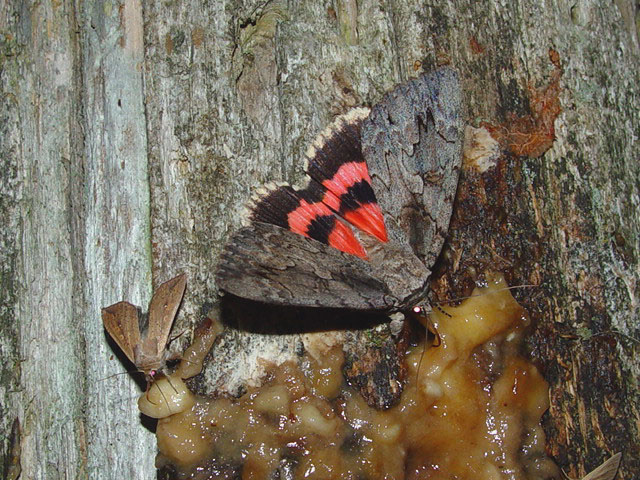
Probable natural hybrid between cara and amatrix,
August 24, 2006, Peterborough, Ontario, courtesy of Tim Dyson,
identification supported by Larry Gall.
Harry Dale King writes, August 30, 2011, "Catocala relicta and Catocala briseis are two real northern species. In Michigan you would have to go as far north as Clare County or farther to get briseis. There is one colony of relicta near Lansing at Bear Lake Bog, a small bog area that has a lot of Birch, high bush Blue Berry and other northern plants. Catocala gracilis and sordida are also taken there. Otherwise its much farther north for these. Relicta has been taken in the mountains in some states like Pennsylvania.
Many thanks to Gloria Beckstrom who provides the following images.
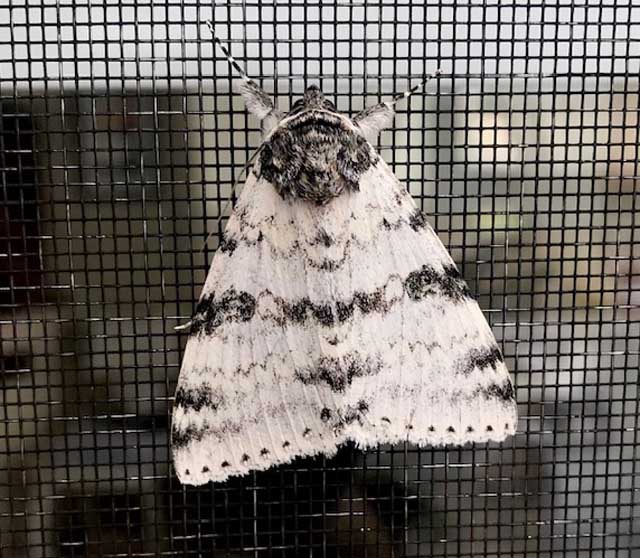
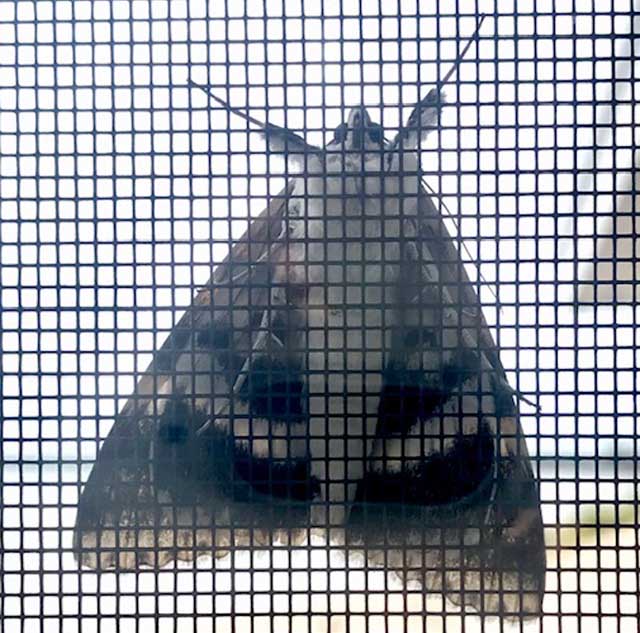
Little Yellow-Orange Underwings: Wingspans: 35-45mm
Little Yellow-Orange Underwings: Wingspans: 35-56mm |
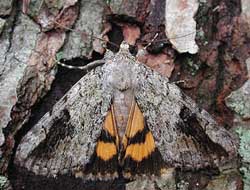
| ** 8876 Catocala micronympha, the Little Nymph Underwing, (wingspan: 35-50mm). John Himmelman image. Usual specimens have grey forewings shaded with green, brown, black and white tints. Usually a darkened band passing from costa through reniform spot to outer margin. High variability. Full size Joe Garris photo of C. micronympha form hero. |
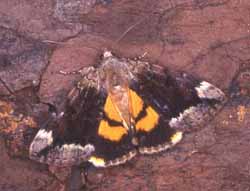
| ** 8876 Catocala micronympha
form gisela,
the Little Nymph Underwing, (wingspan: 35-50mm). |
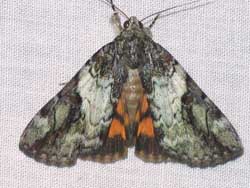
| ** 8876 Catocala micronympha
form hero,
the Little Nymph Underwing, (wingspan: 35-50mm).
The usual specimens have grey forewings shaded with green, brown,
black and white tints. There is usually a darkened band passing from
the costa through the reniform spot to the outer margin.
Form "hero" H. Edwards has a median area that is mostly white. |
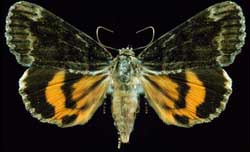
| ** 8876 Catocala micronympha form lolita, the Little Nymph Underwing, (wingspan: 35-50mm).Form "lolita" Sargent has very dark forewings. Harold J. Vermes image, used with permission from his son. |
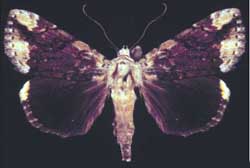
| ** 8876 Catocala micronympha form sargenti, the Little Nymph Underwing, (wingspan: 35-50mm). Usual specimens have grey forewings shaded with green, brown, black and white tints. Usually a darkened band passing from costa through reniform spot to outer margin. Form "sargenti" Covell (very rare) has a hindwing that is all black. |
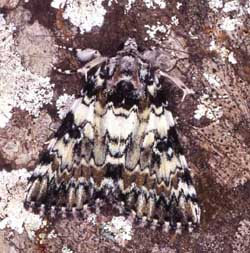
| ** 8877 connubialis, Connubial Underwing, (wingspan: 35-50mm). Fw highly variable; several different forms: "sancta": typical form, fws with white ground colour and sharply contrasting black lines and markings. Brown shading between post medial and subterminal lines; "cordelia": coloured as above, markings faint; "pulverulenta": grey-green fws with faint markings, sometimes none; "broweri": melanic form with fws dark green, almost black. Hw: separate anal spot, outer band ends with a straight cut. Leroy Simon image. |
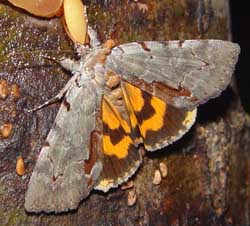
| ** 8864 Catocala grynea ; Woody Underwing, 40-50mm: The forewing is a dull greenish grey with orangey-brown shading along the inner margin. The antemedial, median and postmedial lines are quite faint. Praeclara is somewhat similar but has a break in the brown shading between the am and pm lines. Praeclara also has a paler orange hindwing color. Tim Dyson image. |
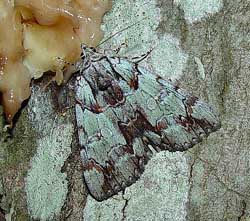
| ** 8865 praeclara; Praeclara Underwing, wingspan: 40-50mm. Fw pale greenish-grey with considerable contrasting brown shading beyond post medial line. There is a black basal dash very close to the inner margin and another dash, higher up in the median area. Note the contrasting shapes of the reniform and subreniform spots. Upper of two larger pml teeth is longer, wider than lower tooth. Note double, white filled amls. Lighter, subcircular patch, outlined in black, brown on lower thorax. |
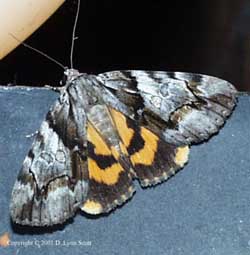
| ** 8867 Catocala blandula; Charming Underwing, wingspan: 40-50mm. Pale basal area of forewing distinguishes mira from blandula (dark brown) and crataegi (black). Fw has dark contrasting lines as in crataegi. There is also considerable brown in subterminal area and subreniform spot is very conspicuous and usually brown. Light area runs obliquely from costa to subreniform spot. Hw is deep orange and has complete inner black band. Outer black band is unbroken. Lynn Scott image. |
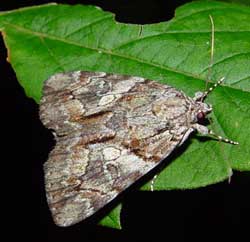
| Catocala mira; Wonderful Underwing, wingspan: 40-50mm. Pale basal area of fw distinguishes mira from blandula (dark brown) and crataegi (black). Fw lacks dark contrasting lines of crataegi and blandula. Considerable brown in subterminal area and subreniform spot very conspicuous, usually brown. Light area runs obliquely from costa to subreniform spot. Noticeable space along i. m. between antemedial and postmedial lines. Hw deep orange and has a complete inner black band. The outer black band is unbroken Tim Dyson image. |
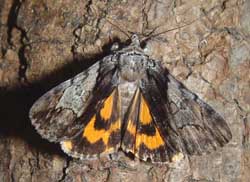
| ** 8858 Catocala crataegi WO; Hawthorn Underwing, 40-50mm. Determination is based on dark (black) shading in forewing basal area continuing along inner margin to anal angle and brown shading beyond postmedial line. There is also a definite greenish cast to median area. The lower wing has the outer black band, broken near the anal angle, distinguishing crataegi from blandula. Tim Dyson image. |
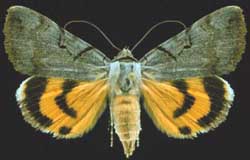
| ** 8841 Catocala abbreviatella BG; Abbreviated Underwing; 40-50mm. Fw uniformly colored with narrow black lines on anterior half. Brown reniform spot ringed with black. Hw outer black band abbreviated and then continued with dot. Inner black band terminates well before im. Similar species: C. nuptialis solid black reniform spot. C. whitneyi broad dark triangles mid fw. |
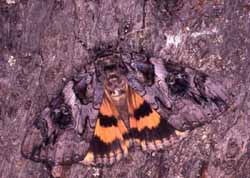 |
** 8844 amestris; Three-staff Underwing; wingspan 43-50mm.There is a large pale patch near the apex. In form "westcotti" the hindwing outer black band is complete. In other moths, the band is broken as in abbreviatella. Hindwing ground colour is usually deeper yellow-orange than in similar species. Leroy Simon image. |
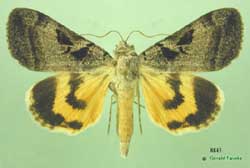
| ** 8843 whitneyi TM; Whitney's Underwing, wingspan 45-50mm. Catocala whitneyi is similar to abbreviatella Grote, and nuptialis Walker, but generally flies later in the season where the species overlap. The two black wedges/triangles on the forewing, one over the reniform spot and the other just outside the antemedial line, distinguish whitneyi. Gerald Fauske image. |
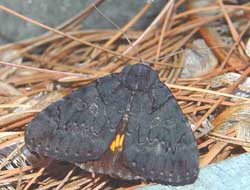
| ** 8775 antinympha; Sweetfern Underwing, wingspan 45-55mm. The very dark grey, almost black, forewing ground colour distinguishes antinympha. There is some brown shading in the subreniform spot and also just outside the postmedial line. The hindwing is amber to pale orange. There is also the form multoconspicua Reiff, 1919 with a pale, almost white subreniform spot. Tim Dyson image. |
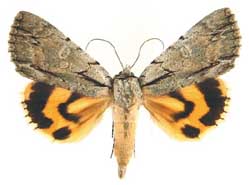
| ** 8772 clintoni; Clinton's Underwing, wingspan 45-55mm.The black basal dash distinguishes clintoni from illecta and abbreviatella, both of which lack the dash. Vernon Brou image. |
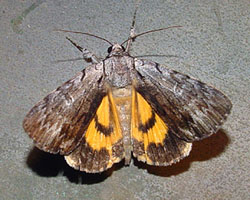
| ** 8772 gracilis; Graceful Underwing, wingspan 40-45mm.Gracilis closely resembles sordida but the hindwing loop is not complete in gracilis as it is in sordida. Gracilis also tends to have a darker inner margin and there is frequently (99% of the time, Dale Schweitzer, via Joe Garris), but not always, a basal dash. Sordida never has the basal dash. |
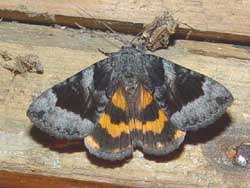
| ** 8776 badia coelebs; Old Maid Underwing, wingspan 54-56mm.The gray region from the forewing pm line to the outer margin readily distinguishes this species. The fringe is gray on the lower wing from the brief orange dash at the hindwing apex to the anal angle. Tim Dyson image. |
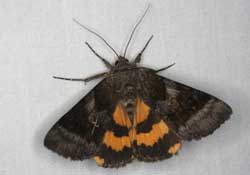
| ** 8777 Catocala badia; Bay Underwing, 50-60mm. Fw buff-brown, deeper brown in basal area and within pm line; paler beyond pm line; lines faint, barely traceable. HW yellow-orange with black bands; often with terminal yellow-orange line at base of fringe. NH. specimens may appear transitional to coelebs, having the sharp bend of upper part of pm area and more distinct lines of that species." |
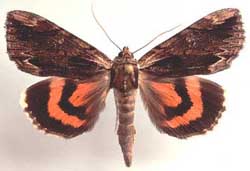
| ** 8857 Catocala ultronia; Ultronia Underwing, wingspan: 50-63mm.Fws typically gray-brown, with a distinct and very dark inner margin and characteristic light brown patch, underscored by very dark arc, near wingtip. Underwings can be yellow to orange to salmon. |
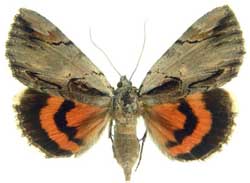
| ** 8857 Catocala ultronia form lucinda; Ultronia Underwing, wingspan: 50-63mm.In form lucinda most of the forewing is bright grey. On all forms there is
extensive orange-salmon colouration on hw ventral surface,
and there is a dark discal lunule. |
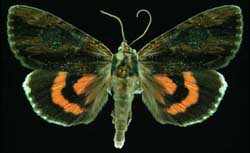
| Catocala ultronia, form nigrescens, the Ultronia Underwing, wingspan: 50-63mm. In the melanic form nigrescens, the dorsal forewing is very dark. Even darker subapical arc, basal dash and dash near anal angle are still visible. Dark basal hairs on hindwing. Harold J. Vermes slide, used with permission from his son. |
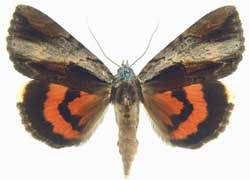
| Catocala ultronia form celia.
In form celia there is a wide, light grey band separating a dark region along inner margin and
a dark patch near the apex.
The ventral surface of forewings of all forms has a generous suffusion
of orange-salmon scales in the lower half of the median area. |
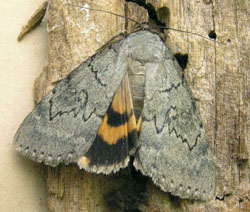 |
** 8779 serena Serene Underwing. 55-60mm. Head, collar and abdomen are brown while thorax is grey. Am and pm lines are thin but very dark and distinct on an otherwise drab, almost uniformly olive-grey forewing. Black marginal band of the lower wings is indented at the center, and relatively narrow, deep yellow median band parallels this indentation. Basal hairs are brown. Catocala serena courtesy of Carroll Rudy. |
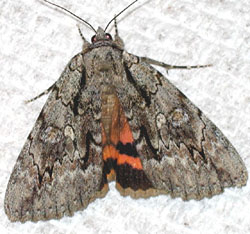
| #8778
Catocala habilis;
wingspan: 55-65mm |
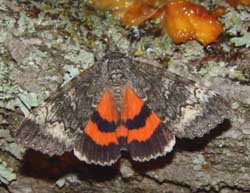
| #8817 briseis; Briseis Underwing; 60-70mm. Forewings are predominantly a mottled dark-grey-brown with some lighter areas 1) between postmedial and subterminal lines, 2) at very base of antemedial and postmedial lines along the inner margin, and 3)over the subreniform spot running diagonally toward the costa. The postmedial lines do not have greatly elongated and sharly pointed "teeth" near apex. The hindwing fringe is white and unbroken and inner black band (fairly even) reaches inner margin. Tim Dyson image. |
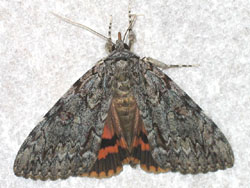
| #8795 Catocala palaeogama ; wingspan: 60-70mm. Subreniform spot closed, does not approach pm line, is smaller than in C. habilis. All forms have characteristic orange, heavily barred fringe to apex, and irregular bands on hws. Hw basal median area heavily suffused with dark brown to black scales. Dark bar in outer half of median area, paralleling i. m. halfway between i. m. and light, closed subreniform spot. Joe Garris photo. |
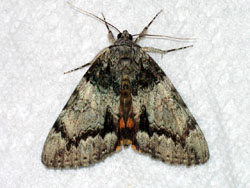
| #8795 Catocala palaeogama form phalanga; wingspan: 60-70mm. In this form, fw basal area and subterminal area are very dark against a much lighter background. Dark bar in the outer half of the median area, paralleling the inner margin halfway between the inner margin and the light, closed subreniform spot is especially evident. Joe Garris image. |
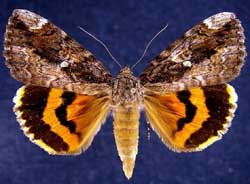
| ** 8770 Catocala innubens; Betrothed; 55-72mm. Forewing is mottled with white, grey and brown, and subrenifrom spot tends to be lighter in colour, although it is sometimes obscured by an indistinct blackish bar which runs from middle of basal/thorax connection to just below much lighter apex at outer margin.Jim Vargo image. |
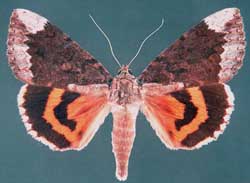
| ** 8770 Catocala innubens form scintillans; Betrothed; 55-72mm.In form scintillans most of the basal area (all but lower third) and all of the median area of the forewing is dark reddish brown. The area outside the pm line is grey. Vernon A Brou image. |
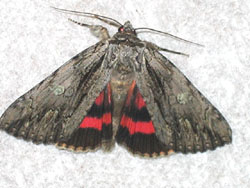
| ** 8851 Catocala coccinata; Scarlet; 57-70mm. There are usually diffuse basal and anal dashes on an otherwise light grey, mottled fw. Hindwing fringe is white (often with some salmon scaling) and is heavily checked. I find "tooth" just below pair of very elongated "teeth" is much reduced and is quite rounded, usually allowing considerable room for lighter patch of scales. Dark bar crosses thorax. Reniform spot tends be to light, often with greenish cast. Joe Garris image. |
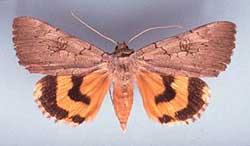
| ** 8840
Catocala illecta;
Magdalen Underwing, wingspan: 60-70mm |
Solid Black Underwings: Smallest to Largest, Similar Species Paired
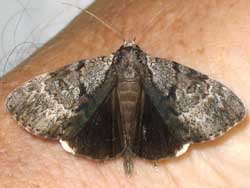
| Catocala andromedae, Gloomy Underwing, (wingspan: 40-50mm). Black underwings and dark grey fringe of hws, coupled with dark i.m. of fws help to identify this species. There is also a very dark "flying saucer" shape, adjoining subreniform spot to midpoint of am line. The "teeth" of pm line short and blunt, outwardly edged with white. Subterminal line is also outwardly edged with white. |
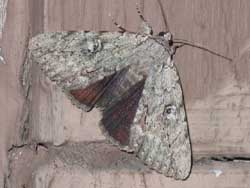
| ** 8781 judith, Judith's Underwing, 45-55mm; one of smaller "black" underwings. Fw uniform light grey with thin, only slightly darkened antemedial, median & pm lines. No darkened dashes (slight anal dash) or transverse lines. Reniform area slightly darkened while the area just before the subterminal line is a bit lighter. Note absence of hw white fringe. Joe Garris photo. |
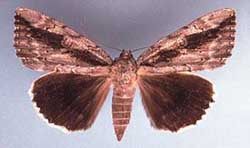
| ** 8782 Catocala flebilis ; Mournful, wingspan: 54-65mm. Diffuse black band runs from basal area to outer margin just below apex, interrupted by pale grey subreniform spot. Reniform spot filled with brown, additional brown outside postmedial line. No anal dash as in angusi. Hws have white fringe. |
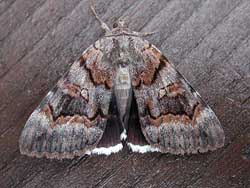
| ** 8773
Catocala epione , yes;
Epione Underwing, wingspan: 55-65mm |
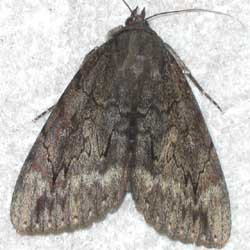
| Catocala residua; Residua Underwing, (wingspan: 60-73mm), distinguished from Catocala obscura by grey hw fringe of residua. Catocala obscura has white to off-white fringe and tends to be less common in northern portions of its range. Fw subterminal line/area of Catocala residua tends to be pale as is its open, elongated subreniform spot. Like C. obscura it is otherwise devoid of significant markings except for hint of dark bar running from basal area through reniform spot to o. m. just below apex. |
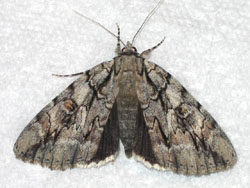
| Catocala retecta; wingspan: 60-75mm. Note light coloured, elongated and open subreniform spot which interrupts dark, diffuse ark running through center of wing from basal area (body-wing juncture) to fw apex. Center of reniform spot brown and there is a brown area just below costa running to inner margin just outside pm line. Off-white hindwing fringe only lightly checked along wing veins. Joe Garris image. |
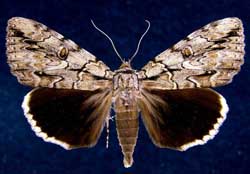
| Catocala luctuosa, Underwing, (wingspan: 70mm). Fw light grey (yellowish tint) clearly marked with a basal dash that continues with another dash through the am line, followed by another anal dash almost forming bar parallel to im. Hw fringe white, lightly barred at veins. Fw pml "teeth" elongated and dark, continuing dark dar emanating from om just below apex. |
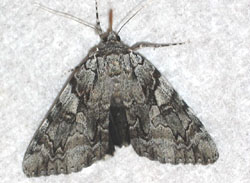
| Catocala dejecta, (wingspan: 56-73mm; Hodge #8790). Dejected Underwing: quite similar to retecta. Here the light coloured subreniform spot is also open, but has distinct "pork-chop" shape and separates much darker median area below subreniform spot from very light area to the costa above spot. Lower quarter of submarginal area also much darker in C. dejecta than in C. retecta. Joe Garris photo. |
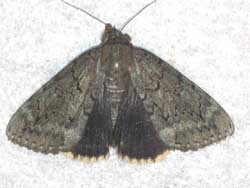
| ** 8784 obscura; the Obscure Underwing, (wingspan: 60-72mm), has dull, grey forewings, usually void of any significant dashes, streaks, providing for easy identification. Am, median and pm lines faint and subterminal line region is only slightly paler than rest of fw. Hw fringe is off-white, lightly checked on veins. Joe Garris photo. |
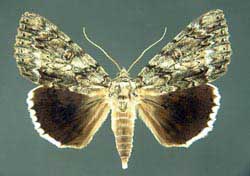
| ulalume; Ulalume Underwing; 62-75mm. Fw colouration is a mottled light to dark grey with no strongly contrasting lines, dashes or bars. At the inner margin the antemedial line ends with in a very light coloured crescent. The subrenifrom spot is also light coloured and "comma" shaped. The hindwing is black and the fringe is pure white with thin, sharp (pointed) checking. |
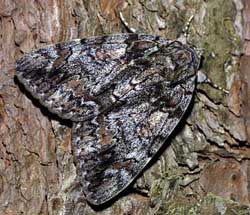
| ** 8794
Catocala lacrymosa;
Tearful Underwing, 60-82mm.
The forewing is highly variable with a mixture of black, brown
(wing tips and outside postmedial line) and dark grey scaling.
There are usually whitish crescents, along the inner margin at the
base of the antemedial and postmedial lines. |
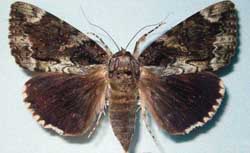
| ** 8794
Catocala lacrymosa;
Tearful Underwing, 60-82mm.
Form paulina: lighter grey post median area & area along and parallel to inner margin, in sharp contrast to
darker basal median areas. |
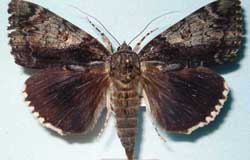
| ** 8794
Catocala lacrymosa;
Tearful Underwing, 60-82mm. |
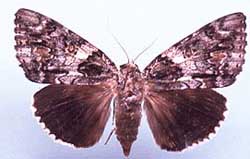
| ** 8794 Catocala lacrymosa; Tearful Underwing, 60-82mm;; GSMNP/TP/WAM/KC. In form albomarginata there is an abundance of white scaling on the forewing. |
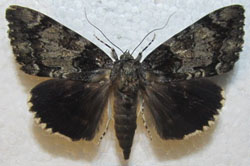
| ** 8794 Catocala lacrymosa; Tearful Underwing, 60-82mm;; TP. Form "zelica", has black basal patch and strong black subterminal line. |
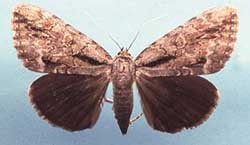
| ** 8783 Catocala angusi
WO; Angus' Underwing, 60-74mm. |
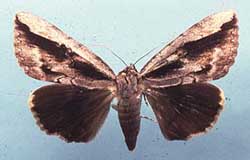
| ** 8783 Catocala angusi WO; Angus' Underwing, 60-74mm; Dark dashes/streaks in basal & anal areas. Reniform spot: light brown filling. Hw fringe black except for white region at apex. Form lucetta has broad black band from basal area to om, broken only by reniform & subreniform spots. James K. Adams image. |
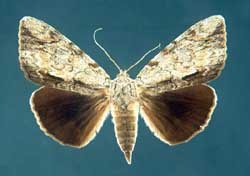
| ** 8791
Catocala insolabilis;
Inconsolable, wingspan: 65-75mm;
Fw light grey with blackish shading along inner
margin. Antemedial and postmedial lines are thin.
Hw fringe very narrow and grey, becoming whiter toward
apex.
Ventral surface clearly distinguishes insolabis, being almost
completely black except for some white in basal area. |
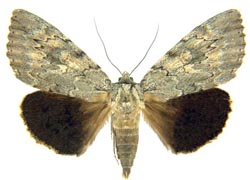
| ** 8780 Catocala robinsoni; 70-80mm. Fws relatively plain pale grey. Female has basal dash, absent in male. Currata French, 1882, female form: weak basal dash. Rare form missouriensis Schwarz, 1915: dark, broad bar extending from basal area to o.m. just below apex. Lighter grey rnfm, subrnfm spots break bar in missouriensis, found from PA. to FL. Hw fringe: White; bands on ventral surface prominent. RARE |
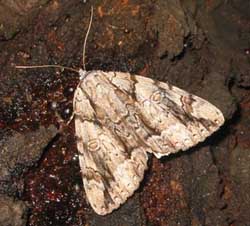
| ** 8792 Catocala vidua; Widow; 70-80mm. Fw ground colour light grey. Distinguishing dark arc runs through top of reniform spot to just below apex. Heavy, dark anal and basal dashes, connecting to dark median bar, running parallel to i. m. Am line thick, black in its upper half. Reniform spot with two almost concentric irregular ovals. Subreniform spot light, open, constricted as it meets pm line. Hw black with broad, white fringe, lightly interrupted. Marie Winn image. |
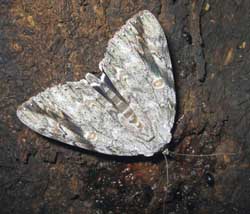
| ** 8793
Catocala maestosa WO/BG,
Sad Underwing, wingspan: 78-98mm |
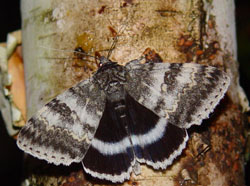
| ** 8803 Catocala relicta
;
Forsaken, White, Relict; 70-80mm:
Considerable variation with regard to black/white
concentrations on fws. |
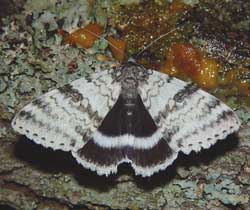
| ** 8803 Catocala relicta ; Forsaken, White, Relict; 70-80mm: Considerable variation with regard to black/white concentrations on fws. Form clara: basal and subterminal areas predominantly white.Typical specimens have basal and subterminal areas with blackish scales. Black hws, with brilliant even white inner band and white fringe, are distinctive. June until October. |
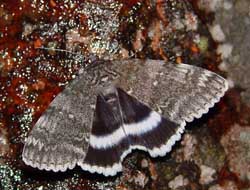
| ** 8803 Catocala relicta ; Forsaken, White, Relict; 70-80mm: Considerable variation with regard to black/white concentrations on fws. Form phrynia: evenly dusted with grey over entire forewing. Typical specimens have basal and subterminal areas with blackish scales. Black hws, with brilliant even white inner band and white fringe, are distinctive. June until October, poplars and willows |
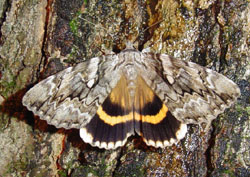
| ** 8802 Catocala cerogama; Yellow-Banded; 70-80mm. Several different forms. Pm line distinct, dark and has elongate pair of projections. Pm and am lines meet inner margin in relative proximity. Closed subreniform spot lighter than surrounding areas, shaped a bit like an arrowhead with point toward body. Hws are distinctive. Jean-Benoît Duval image. |
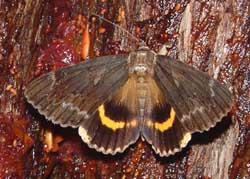
| ** 8802 Catocala cerogama; Yellow-Banded; 70-80mm.Form ruperti: Forewings are almost uniform grey-brown with white scales outlining subterminal line. The hindwings are distinctive. Tim Dyson image. |
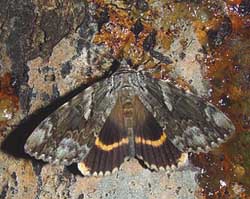
| ** 8802 Catocala cerogama; Yellow-Banded; 70-80mm.Form bunkeri: Forewings are dark in median and basal areas. Hw golden band is reduced in thickness. Basal hairs are brown instead of yellow. The hindwings are distinctive. Tim Dyson image. |
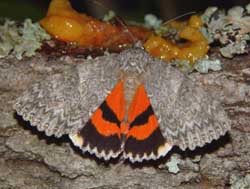
| ** 8822 meskei TM; Meske's Underwing; 65-75mm. Fws less distinctly marked compared to unijuga, some red-orange at the hindwing apex and just inside the fringe along the outer margin in meskei that is lacking in unijuga. Fw subreniform spot is opened or connected to the postmedian line. The hindwing postmedian band nearly straight, turned in and tapering near anal angle. Tim Dyson image. |
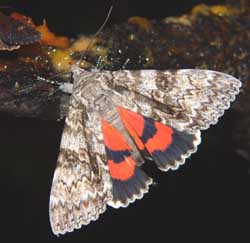
| ** 8821 semirelicta; Semirelict Underwing; wingspan: 65-75mm. Fw ground colour white with dark lines and shadings. Diffuse dark bar runs from center of basal area to outer margin a few mm above anal angle. Note regular dentation of st line. Inner black bar on lower wing usually terminates well before inner margin. The form "atala" has forewing that is uniformly grey. Unijuga is usually larger and has less contrasting black lines. Inner black bar on unijuga usually reaches inner margin. Tim Dyson image. |
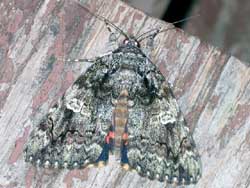
| ** 8801 Catocala ilia; Ilia; wingspan: 65-82mm. Several different forms, most have characteristic white area in and around reniform spot. Diffuse dark arc running from this spot to just below apex. Subreniform spot squarish, concave inner and outer edges and elongated constriction connecting it to pml. White dots near fw om in character with the overall "contrasting" appearance. |
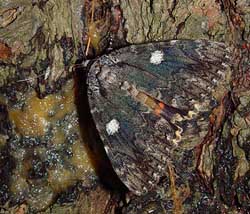
| ** 8801 Catocala ilia; Ilia; form conspicuaIn this form the entire reniform spot is heavily suffused with white scaling on an otherwise darker ground colour. Hence the form name "conspicua". Tim Dyson image. |
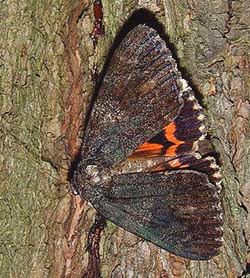
| ** 8801 Catocala ilia; Ilia; form satanasIn this melanic form the entire forewing, including the reniform spot is very dark. Hence the form name "satanas". The dark basal streak is still evident on this form. Tim Dyson image. |
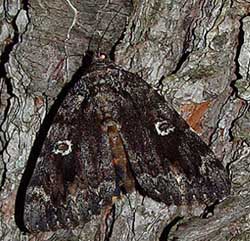
| ** 8801 Catocala ilia; Ilia; form normaniIn this semi-melanic form the entire forewing, excluding the reniform spot, is relatively dark. The brownish, kidney-shaped center of the reniform spot is outlined in white. The basal streak and subapical arc are still visible. Tim Dyson image. |
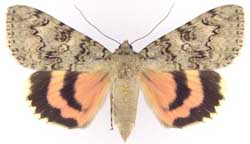
| ** 8808 luciana; Luciana Underwing, 57-68mm. Pale grey brown forewing with very distinct am & postmedial lines. Subreniform spot has elongated narrow "tail" that seems to open through postmedial line. Inner black band of hw does not reach inner margin. Fringe is checked and paler (almost yellow) than salmon ground colour. |
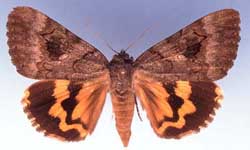
| ** 8772 Catocala consors WO; Consort, wingspan: 70mm plusThe forewing has irregular am and pm narrow black lines. There is a dark patch outside the reniform and subreniform spots. The orange-yellow hindwing pm band tends to be narrow and irregularly zigzagged. Sometimes the band is wider and slightly less irregular. James K. Adams image. |
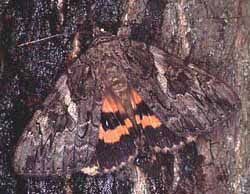
| ** 8771 Catocala piatrix ; Penitent, wingspan: 68-84mm. Fw: light-colored band/bar extending from light coloured, triangular subreniform spot along am line to costa. Brown, kidney-shaped reniform spot surrounded in pale grey, outlined in black, usually with distinct black along wing veins in a dark area outside the reniform spot. Hw: fringe lightly barred; lighter in color than deeper orange on rest of wing. |
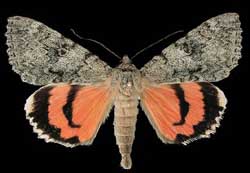
| Catocala junctura; Joined Underwing; 67-85mm. Fw is usually dark brownish-gray to evenly powdered blue-grey w/o significant markings. Doubled reniform spot often obscure. Thin, slightly darker am and pm lines run from costa to im, not widely spaced at im. Hw salmon/ orange-pink, narrow inner black band turns in sharply, does not meet dark-haired im. |
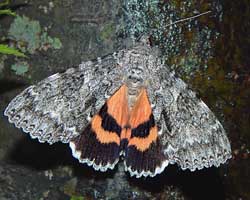
| ** 8805 unijuga; Once-married; wingspan: 70-90mm: Catocala unijuga has a fairly wide black inner band (almost reaching inner margin) in hindwing and very distinctive patterning in forewing. Meskei tend to have narrower band and dustier (less distinct) looking forewing. Semirelicta tend to have inner bands that terminate well before inner margins. Also note the very white fringe on both the forewings and hindwings. Carroll Rudy image. |
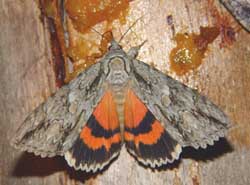
| ** 8806 Catocala parta; Mother Underwing, 70-85mm. The black dashes in the basal, subapical and anal areas help to identify this species. The hindwings may be yellow to yellowish-orange but more often are salmon-red. Note the face-head-like markings on the thorax. In the hindwing, the first (nearest the apex) black protrusion into the white fringe is "noticeably" larger than the others. |
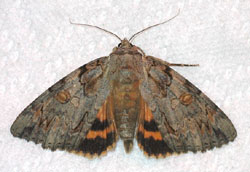
| ** 8798 Catocala neogama; wingspan 70-85mm. Brown head, thorax, larger size as compared to C. palaeogama. Neogama tend to be slightly smaller than subnata, have darker grey brown fws with more pronounced markings. Examination of hind tibia needed for id. Neogama's: flattened, unevenly, sparsely spined; subnata's: cylindrical, spines dense, uniform in distribution. Joe Garris photo. |
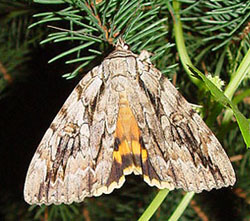
| ** 8797 Catocala subnata; Youthful Underwing: 75-90mm. Fws greyish white with blue-grey and light brown scales, usually with hws brighter yellow than those of neogama. Neogama usually have basal dash; absent in male subnata, but present in females. Magnification of hind tibia needed for id: subnata: cylindrical hind tibia; neogama: compressed or flattened hind tibia. subnata: ventral surface of tibia densely covered with evenly distributed spines; neogama: ventral surface of tibia sparsely covered. |
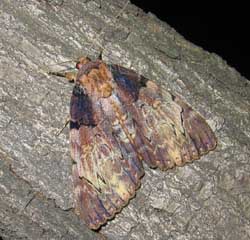
| Catocala nebulosa; Moths have prominent dark brown upper-half-basal patch that extends to and ends at antemedial line. Apical area also tends to be brown, much darker than median area but not as dark as basal patch. The anal angle also has the darker brown scaling. The pm line is distinct near costa and inner margin, but becomes weak between the two. It meets inner margin in relative close proximity to am line. Closed subreniform spot is large and connects to the pm line via a thin line. |
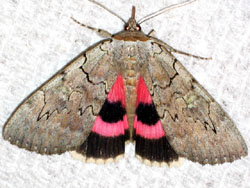
| ** 8833 concumbens Sleepy Underwing or Pink Underwing, 60-75mm). This brown thoracic collar is quite evident in this image as is the interruption in the pm line by the open subreniform spot.The white hindwing fringe is only lightly checked on the wing veins. The vibrant pink bans are distinct in colour and also in their relatively smooth contour. |
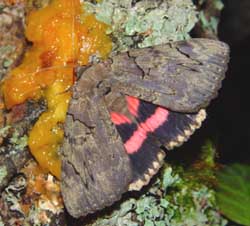
| ** 8832 Catocala cara;
Darling; 70-85mm.
Note deep maroon almost purple cast to fws, mixed with
very pale green. Lower half of am & pm lines is barely
visible. There are no distinctive bars or dashes. The two upper
"teeth" on the pm line are thin and long. |
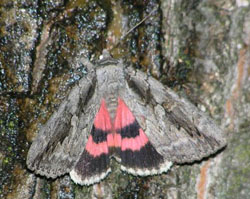
|
** 8834 amatrix Sweetheart Underwing; (wingspan 75-95mm). Very skittish, frequently hides in caves, under bridges, under tree bark, etc. by day, resting with head down. Hw patterning and colouration similar to that of C. concumbens, but large size (wingspan 75-95mm) and dark bar running from basal area to just below apex distinguishes C. amatrix. See large Catocala amatrix courtesy of Joan F. Rickert. |
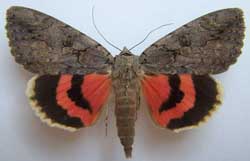
|
** 8834 amatrix form selecta
Sweetheart Underwing; (wingspan 75-95mm) |
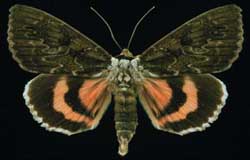
|
** 8834 amatrix form hesseli
Sweetheart Underwing; (wingspan 75-95mm) |
Return to Canadian Index
Return to Main Index
Enjoy some of nature's wonderments, giant silk moth cocoons. These cocoons are for sale winter and fall. Beautiful Saturniidae moths will emerge the following spring and summer. Read Actias luna rearing article. Additional online help available.
Eggs of many North American Saturniidae species are offered during the spring and summer. Occasionally summer Actias luna and summer Antheraea polyphemus cocoons are available. Shipping to US destinations is done from within the US.
This page is brought to you by Bill Oehlke and the WLSS. Pages are on space rented from Bizland. If you would like to become a "Patron of the Catocala Site", contact Bill.
Please send sightings/images to Bill. I will do my best to respond to requests for identification help.

|
butterfly to the left, a link to many worldwide insect sites. |
The following table divides Michigan Catocala species into twenty one different groups. Moths are grouped according to hindwing colour bands (yellow, orange, salmon, red, pink, black or white) and wingspan measurements (small = 30-55mm, medium = 55-75 mm and large = 75mm plus).
Wingspan refers to the distance from wing tip to wing tip when the moths are spread with the inner margin of the forewing perpendicular to the body.
This list is adopted/modified from a list provided by Jeff Crolla for Ontario, Canada.
Many thanks to Tim Dyson of Peterborough, Ontario, and to Maurice Bottos of Windsor, Ontario, for sightings and images. Both collect at bait.
From Windsor, Maurice reports black underwings: insolabilis, retecta, obscura, residua, vidua and judith (judith is rare...only 1 or 2 a year)
which seem to be absent in Tim's more northerly location.
Maurice has also sent images of C. amatirix, piatrix, habilis, vidua, mira, blandula, serena, ilia, palaeogama, unijuga and crataegi.
I have used the Ontario listings, coupled with listings for Wisconsin, Illinois and Ohio
to create this checklist. There may be erroneous inclusions and some omissions,
however, I feel the list should be useful and probably at least 85% accurate, i.e., not more than 9 omissions and/or
erroneous inclusions.
YELLOW |
ORANGE |
SALMON |
RED |
PINK |
BLACK |
WHITE
|